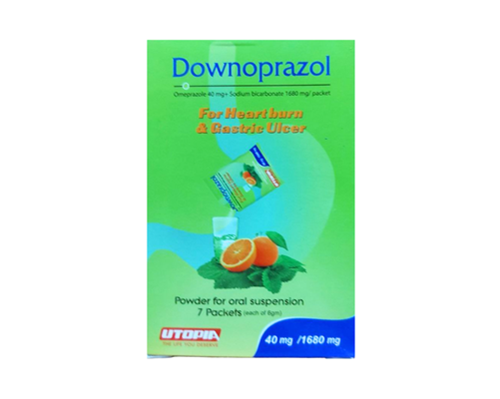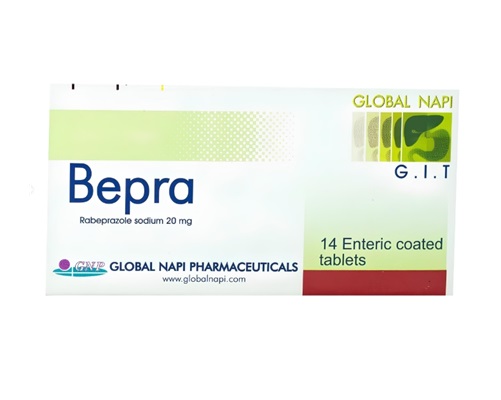Description
Trade name:
Downoprazole
Compound:
Each sachet contains:
Omeprazole 20 mg
Sodium bicarbonate 1680 mg
Auxiliary components:
Aspartame sodium carboxymethyl cellulose, orange flavor, menthol flavor, sucrose.
Properties:
Omeprazole inhibits the enzyme H+-K+-ATPase (“proton pump”) in the parietal cells of the stomach and thereby blocks the final stage of hydrochloric acid synthesis. This leads to a decrease in the level of basal and stimulated secretion, regardless of the nature of the irritant. After a single oral administration of the drug, the effect of omeprazole occurs within the first hour and lasts for 24 hours, the maximum effect is achieved after 2 hours. In patients with duodenal ulcer, taking 20 mg of omeprazole maintains intragastric pH = 3 for 17 hours. After stopping the drug, secretory activity is completely restored after 3-5 days.
Indications:
Peptic ulcer of the stomach and duodenum;
reflux esophagitis;
erosive and ulcerative lesions of the stomach and duodenum associated with the use of NSAIDs;
stress ulcers;
erosive and ulcerative lesions of the stomach and duodenum associated with Helicobacter pylori (as part of complex therapy);
Zollinger-Ellison syndrome.
Method of administration and dosage:
Take in the morning 1 hour before meals. Pour the contents of the sachet into a glass with 20 ml of water, stir and drink. Do not use any other liquid except water!
Doses for people over 18 years of age:
Gastric ulcer in the acute phase and erosive-ulcerative esophagitis: 20-40 mg per day for 4-8 weeks.
Eradication of Helicobacter pylori: 20 mg once a day for 7 days in combination with antibacterial agents.
Zollinger-Ellison syndrome: the dose is selected individually depending on the initial level of gastric secretion, usually starting from 60 mg/day. If necessary, the dose is increased to 80–120 mg/day, in which case it is divided into 2 doses.
Contraindications:
Hypersensitivity to the drug;
childhood;
pregnancy;
lactation period.
Precautions:
Before starting therapy, it is necessary to exclude the presence of a malignant process (especially in the case of a stomach ulcer), since treatment, by masking the symptoms, can delay the correct diagnosis.
Taking it with food does not affect its effectiveness.
In patients with severe liver failure, the daily dose should not exceed 20 mg.
Side effects:
In rare cases, the following usually reversible side effects may occur.
From the digestive system: diarrhea or constipation, nausea, vomiting, flatulence, abdominal pain, dry mouth, taste disturbances, stomatitis, transient increase in the level of liver enzymes in plasma; in patients with previous severe liver disease – hepatitis (including jaundice), liver dysfunction.
From the nervous system: headache, dizziness, agitation, drowsiness, insomnia, paresthesia, depression, hallucinations; in patients with severe concomitant somatic diseases, in patients with previous severe liver disease – encephalopathy.
From the musculoskeletal system: muscle weakness, myalgia, arthralgia.
From the hematopoietic system: leukopenia, thrombocytopenia; in some cases – agranulocytosis, pancytopenia.
From the skin: itching; rarely (in isolated cases) – photosensitivity, erythema multiforme, alopecia.
Allergic reactions: urticaria, angioedema, bronchospasm, interstitial nephritis and anaphylactic shock.
Others: visual impairment, peripheral edema, increased sweating, fever, gynecomastia; rarely, formation of gastric glandular cysts during long-term treatment (a consequence of inhibition of hydrochloric acid secretion, benign and reversible).
Storage method:
Store in a dry, dark place at a temperature not exceeding 30 degrees.
Package:
The cardboard box contains 7 sachets of 6 g each and paper instructions.









